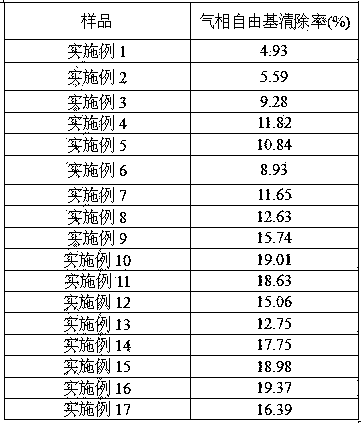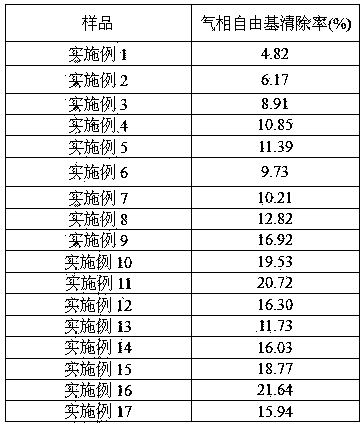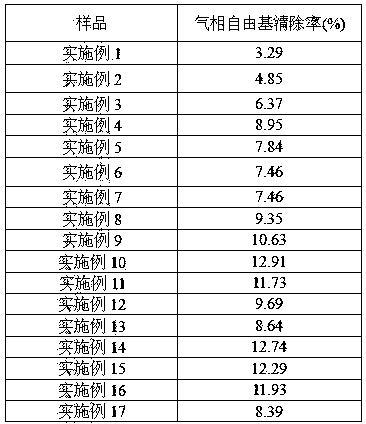Squalene and beta-carotene composition polycystic lipidosome preparation method and application thereof for decreasing free radical and reducing harm
A multivesicular liposome and carotene technology, applied in the field of chemistry, can solve problems such as no report, no multivesicular liposome preparation technology and application report, etc., and achieves strong air permeability, large surface area, and increased stability. Effect
- Summary
- Abstract
- Description
- Claims
- Application Information
AI Technical Summary
Problems solved by technology
Method used
Image
Examples
Embodiment 1
[0049] Prepare each component according to the following parts by mass: 15 grams (g) of lecithin; Those skilled in the art can use other sources of squalene) 5 grams (g); Those skilled in the art can use other sources of β-carotene) 45 grams (g); cetyl alcohol 15 grams (g); low molecular weight hydroxyethyl starch 20 grams (g).
[0050] The preparation steps are:
[0051] S1. Dissolving phospholipids, squalene and β-carotene in 100mL propylene glycol to obtain a mixed system;
[0052] S2. Transfer the mixed system obtained in S1 into 50 mL of water containing 15 g of cetyl alcohol, homogenize at a high speed to make it fully mixed, and obtain a homogenized mixed system;
[0053] S3. Add low molecular weight hydroxyethyl starch to the homogenized mixing system obtained in S2 and stir evenly to form a stable particle suspension;
[0054] S4. Freeze-drying the microparticle suspension obtained in S3 to obtain multivesicular liposomes containing squalene and β-carotene.
Embodiment 2
[0056] Each component was prepared according to the following parts by mass: 15 grams of soybean lecithin; 10 grams of squalene; 40 grams of β-carotene; 15 grams of stearyl alcohol; 20 grams of low molecular weight hydroxyethyl starch.
[0057] The preparation steps are:
[0058] S1. Dissolve soybean lecithin, squalene and β-carotene in 100 milliliters (mL) of propylene glycol to obtain a mixed system;
[0059] S2. Transfer the mixed system obtained in S1 into 50 mL of water containing 15 g of stearyl alcohol, homogenize at a high speed to make it fully mixed, and obtain a homogenized mixed system;
[0060] S3. Add low molecular weight hydroxyethyl starch to the homogenized mixing system obtained in S2 and stir evenly to form a stable particle suspension;
[0061] S4. Freeze-drying the microparticle suspension obtained in S3 to obtain multivesicular liposomes containing squalene and β-carotene.
[0062] Water and propylene glycol are used in the preparation process of the mu...
Embodiment 3
[0064] Each component was prepared according to the following parts by mass: 15 grams of hydrogenated soybean lecithin; 15 grams of squalene; 35 grams of β-carotene; 15 grams of glycerin;
[0065] The preparation steps are:
[0066] S1. Dissolve hydrogenated soybean lecithin, squalene and β-carotene in 100 milliliters (mL) of propylene glycol to obtain a mixed system;
[0067] S2. Transfer the mixed system obtained in S1 into 50 mL of water containing 15 g of glycerin, homogenize at a high speed to make it fully mixed, and obtain a homogenized mixed system;
[0068] S3. Add medium molecular weight hydroxyethyl starch to the homogenized mixing system obtained in S2 and stir evenly to form a stable particle suspension;
[0069] S4. Freeze-drying the microparticle suspension obtained in S3 to obtain multivesicular liposomes containing squalene and β-carotene.
PUM
 Login to View More
Login to View More Abstract
Description
Claims
Application Information
 Login to View More
Login to View More - R&D
- Intellectual Property
- Life Sciences
- Materials
- Tech Scout
- Unparalleled Data Quality
- Higher Quality Content
- 60% Fewer Hallucinations
Browse by: Latest US Patents, China's latest patents, Technical Efficacy Thesaurus, Application Domain, Technology Topic, Popular Technical Reports.
© 2025 PatSnap. All rights reserved.Legal|Privacy policy|Modern Slavery Act Transparency Statement|Sitemap|About US| Contact US: help@patsnap.com



